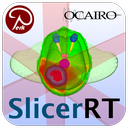3D Slicer
3D Slicer is a free, open source software for visualization, processing, segmentation, registration, and analysis of medical, biomedical, and other 3D images and meshes; and planning and navigating image-guided procedures.
SlicerRT allows users to analyze spatio-temporal accumulation of the therapeutic dosage (radiation, thermal, etc.). Tools include dose visualization, quantitative metrics computation, comparison, and import/export to DICOM format.
SlicerRT is an extension of 3D Slicer, a free, open source software for visualization and image analysis. SlicerRT can be installed from the 3D Slicer Extension Manager on Windows, Mac, and Linux to leverage the advanced features of 3D Slicer in adaptive radiation therapy research
SlicerRT includes close to 20 modules that provide tools for radiation therapy research, including advanced deformable registration methods powered by the Plastimatch library. Standard DICOM-RT format is supported, thus integrating with the treatment planning systems
Our development and research work is public, including source code, data, manuals, presentations, etc. SlicerRT is distributed under the BSD-style Slicer license allowing academic and commercial use without any restrictions. See our OpenHub site for further details.

3D Slicer is a free, open source software for visualization, processing, segmentation, registration, and analysis of medical, biomedical, and other 3D images and meshes; and planning and navigating image-guided procedures.
Software toolkit for rapid development of image-guided therapy systems - for minimally invasive medical procedures, where operators rely on computer-generated images rather than direct sight of the target organs.